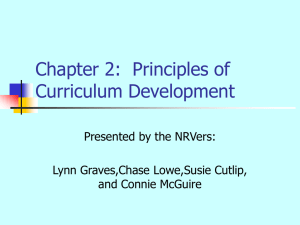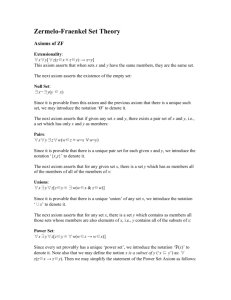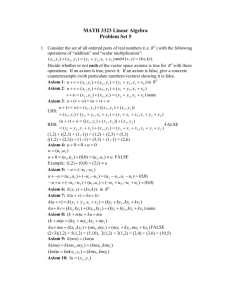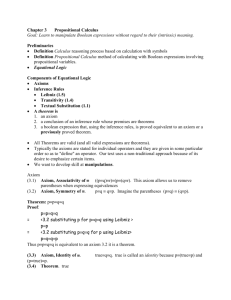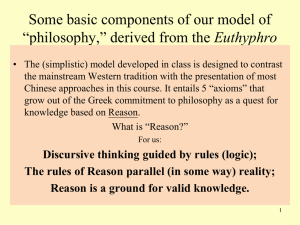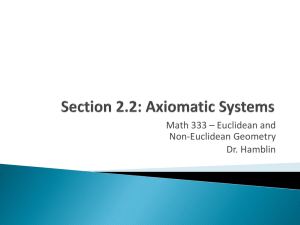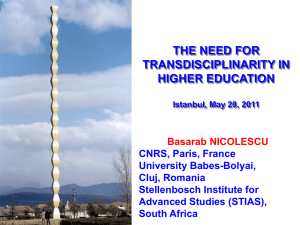doc
advertisement
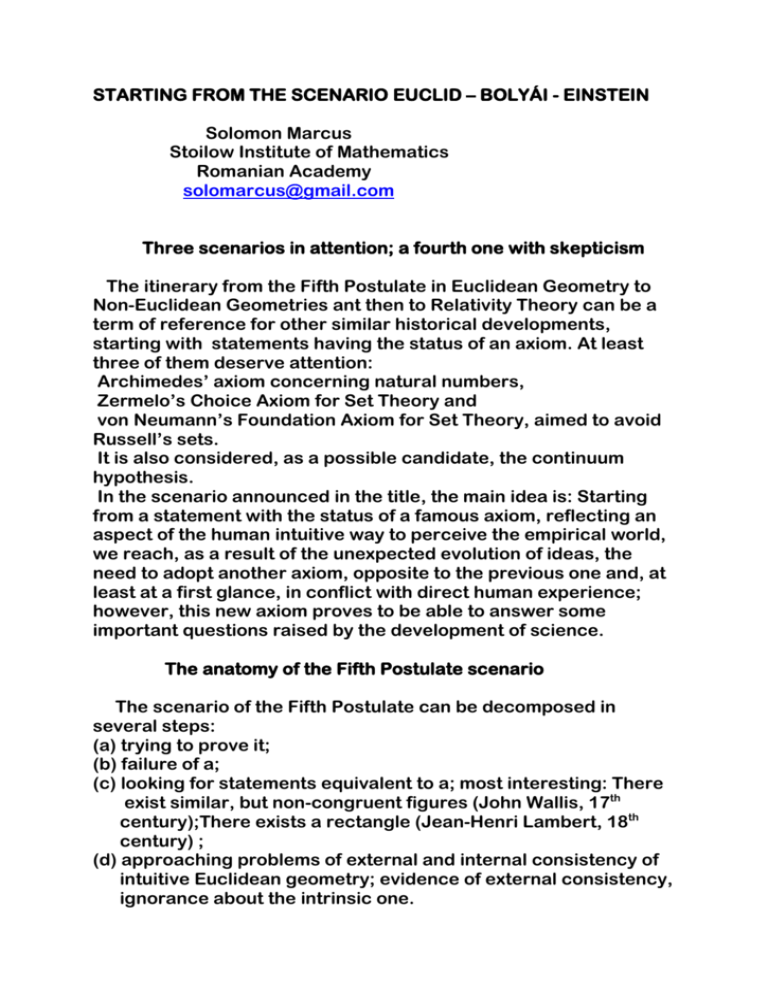
STARTING FROM THE SCENARIO EUCLID – BOLYÁI - EINSTEIN Solomon Marcus Stoilow Institute of Mathematics Romanian Academy solomarcus@gmail.com Three scenarios in attention; a fourth one with skepticism The itinerary from the Fifth Postulate in Euclidean Geometry to Non-Euclidean Geometries ant then to Relativity Theory can be a term of reference for other similar historical developments, starting with statements having the status of an axiom. At least three of them deserve attention: Archimedes’ axiom concerning natural numbers, Zermelo’s Choice Axiom for Set Theory and von Neumann’s Foundation Axiom for Set Theory, aimed to avoid Russell’s sets. It is also considered, as a possible candidate, the continuum hypothesis. In the scenario announced in the title, the main idea is: Starting from a statement with the status of a famous axiom, reflecting an aspect of the human intuitive way to perceive the empirical world, we reach, as a result of the unexpected evolution of ideas, the need to adopt another axiom, opposite to the previous one and, at least at a first glance, in conflict with direct human experience; however, this new axiom proves to be able to answer some important questions raised by the development of science. The anatomy of the Fifth Postulate scenario The scenario of the Fifth Postulate can be decomposed in several steps: (a) trying to prove it; (b) failure of a; (c) looking for statements equivalent to a; most interesting: There exist similar, but non-congruent figures (John Wallis, 17th century);There exists a rectangle (Jean-Henri Lambert, 18th century) ; (d) approaching problems of external and internal consistency of intuitive Euclidean geometry; evidence of external consistency, ignorance about the intrinsic one. (e) consistency problems related to the Parallel Axiom in axiomatic Euclidean geometries (Hilbert, Tarski, Birkhoff); with respect to the consistency problems, the axiomatic case repeats the situation of the intuitive case; (f) consistency of the negation of the Fifth Postulate with respect to the other postulates of Euclidean geometry; the emergence of intuitive non-Euclidean geometries (Lobatchevsky, Bolyái); (g) ignorance about the intrinsic consistency of the non-Euclidean geometry, be it hyperbolic or elliptic; (h) relative consistency of intuitive non-Euclidean geometry with respect to intuitive Euclidean geometry; (i) consistency of hyperbolic geometry with respect to the special theory of relativity; (j) consistency of elliptic Riemannian geometry with respect to the general theory of relativity. The same scenario for Bolyái’s absolute geometry and for set theory under Zermelo-Fraenkel’s axiomatization, without the choice axiom Set theory, under the Zermelo-Fraenkel’s axiomatization, without the axiom of choice, corresponds to Euclidean geometry under Euclid’s axiomatization, without the fifth postulate, which is just Bolyá’s absolute geometry. Zermelo takes the role of Euclid, Euclidan geometr is replasced by the Zermelo-Faenkel’s system of axioms for set theory. Impossibility to prove the fifth postulate corresponds to the impossibility to prove the choice axiom. Looking for statements equivalent to the fifth postulate (Wallis, Lambert etc) is similar to looking for statements equivalent to the axiom of choice (see the book in French by Waclaw Sierpinski, giving a long list of equivalent statements; one of the most spectacular, found later, is M. Solovay’s statement asserting, roughly speaking, the equivalence of the axiom of choice with the existence of Lebesgue non-measurable sets). The independence of the axiom of choice (Gödel, Cohen) corresponds to the fact that both the fifth postulate and its negation are consistent with the other postulates of Euclidean geometry. So, Gödel and Cohen play with respect to the axiom of choice the role Lobatchevsky, Bolyái, Gauss and Riemann had with respect to the fifth postulate. There is also an equivalent of Saccheri: A. Fraenkel, who proved in 1922 a partial independence of the axiom of choice. Now, what corresponds to Einstein’s (special and general) relativity theory? Clearly, mathematics without the axiom of choice is crucial in constructive mathematics, the use of the choice axiom is one of the most non-constructive procedure, incompatible with the algorithmic thinking, so important in today computational approaches in mathematics and in science, in general. Can we replace in the previous section the choice axiom with the continuum hypothesis? Apparently, the answer seems to be affirmative. There is however a difficulty related to the controversial status of the answer to the first problem in the famous Hilbert’s list. While most mathematicians consider it as solved by Gödel and Cohen, some important logicians, such as Martin Davis and Raymond Smullyan, consider it still open. They believe that another, more adequate system of axioms for set theory should be found, where the continuum hypothesis could have a yes or no answer. In the meantime, something unexpected happened: W. Hugh Woodin, a PhD student of Solovay, in his book The axiom of determinacy, forcing axioms and the non-stationary ideal (Berlin, Walter de Gruyter, 1999) and in a series of papers (Notices AMS 48, 2001, , 6, 567-576; Proceedings, Logic Colloquium, Paris, 2000 etc.) leads to the believe that, “for the first time there is a realistic perspective to decide the continuum hypothesis, namely in the negative” (Patrick Dehornoy). The itinerary of the Archimede’s axiom Roughly speaking, Archimede’s axiom, some times called Eudoxus’ axiom, asserts that, given two quantities, each of them, by enough multiplication, overcomes the other. In exact terms, given two natural numbers a and b, there exists a third one n such that the product of n and a is larger than b. Accepted for natural numbers, this property becomes a theorem for integers, for rational and for real numbers. In the 17th century, Leibniz introduced the idea of infinitesimal, as a quantity which is different from zero, but inferior to 1/n for any natural number n. Considered by Leibniz’s followers as absurd, the infinitesimals were pushed away in the next centuries. In the 19th century, it was rejected by Cauchy and Weierstrass and replaced by small infinities, conceived as functions having zero as their limiting value in a certain point. The epsilon-delta reasoning became the new language of mathematical analysis. The general feeling was that Leibniz’s infinitesimals have no perspective, they belong to the past. However, a surprise came in 1933, with the appearance of axiomatic probability theory, proposed by A N. Kolmogorov, where probability is conceived as a measure and becomes a very rigorous concept. Despite the merits of this approach, some shortcomings became also visible. In the new measure-theoretic perspective, a divorce appears between the idea of impossible event and that of zero probability. While, as it is expected, any impossible event is of probability equal to zero, the converse is no longer true: the probability of a real number between 0 and 1 to be an algebraic number is equal to zero, although there exist a lot of algebraic numbers. How can we bridge this unacceptable situation? By considering that the probability for a real number to be algebraic is not zero, but an infinitesimal in the Leibniz’s sense. So, a new look on Leibniz’s idea became necessary and it came in the sixties of the 20th century, when Abraham Robinson invented his Nonstandard Analysis. Within this new framework, Archimede’s axiom is cancelled and free way is opened to the Leibniz’s infinitesimals. As a matter of fact, the existence of Leibniz’s infinitesimals is logically equivalent with the negation of the Archimede’s axiom. But let us observe that both in Leibniz’s dream and in Robinson’s scenario the infinitesimals are never real numbers, they belong to more extensive universes, going beyond the set of real numbers. In this tale, Archimede is Euclid, Robinson is Lobatchevky and Bolyái, Kolmogorov is a kind of Saccheri, but what could be equivalent to Relativity theory? The answer came short time after Robinson’s invention, with the creation of the new field called Nonstandard exchange economy, where the first steps belong just to Robinson, This author, in a joint paper with Donald J. Brown, “Nonstandard exchange economies” (Econometrica, 1975) considers the Edgeworth conjecture claiming that, as the number of traders in an exchange economy increases, the core approaches the set of competitive equilibria. This conjecture can be interpreted either as a statement about a sequence of finite economies or as a statement about an economy having an infinite number of agents. The natural framework to approach and to bridge these two possibilities proved to be nonstandard analysis. A rough explanation of this fact is that under the assumption that the numberof agents s infinite, their total impact is significant and assures a competitive equilibrium, although the impact of each individual agent is negligible, i.e., an infinitesimal. The itinerary of the Foundation Axiom in Set Theory The foundation axiom was proposed in 1925 as a new axiom in Zermelo-Fraenkel axiomatic system of set theory. It asserts that every non-empty set A contains an element B which is disjoint from A. Two consequences follow: (1) no set is an element of itself; (2) no infinite descending sequence of sets exists. Statement (1) makes impossible the appearance of Russell sets. The general mentality hundred years ago was that entities such as Russell sets are pathological objects and should be avoided. Paradox, in general, had a pathological status. But things changed, for well-known reasons, and infinite descending sequences of sets became not only normal, but necessary. Against the assertion (2) above, their existence became legitimate and the respective objects got the name hypersets. Obviously, they are a generalization of Russell sets, which correspond to the particular case in which the infinite descending sequence of sets is stationary. In an alternative approach to the classical, traditional one, the foundation axiom has been replaced by the socalled anti-foundation axiom (Peter Aczel, “Non-well-founded sets”. CSLI Lecture Notes 14, Stanford, 1988). A set is well- founded if it has no infinite descending membership sequence.Non-well-founded set-theories are variants of axiomatic set theory which allow sets to contain themselves and otherwise violate the rule of well-foundedness. In these theories, the foundation axiom of ZFC is replaced by axioms implying its negation. So, Bertrand Russell and John von Neumann are here Euclid, Peter Aczel, Ian Barwise and others are Lobatchevsky, Bolyái and Riemann. What corresponds to relativity theory, i.e., what needs legitimate the anti-foundation approach? There are a lot of questions, coming from the logical modeling of non-terminating computational processes in computer science (process algebra and final semantics), from the theory of data-bases, from linguistics and natural language semantics (situation theory) and from philosophy (Ian Barwise).

